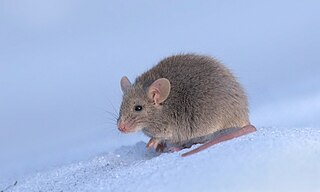Charippus is a genus of spiders in the jumping spider family, Salticidae.

The genus Mus or typical mice refers to a specific genus of muroid rodents, all typically called mice, though the term can be used for other rodents. They are the only members of the tribe Murini. However, the term mouse can also be applied to species outside of this genus.

Chthoniidae is a family of pseudoscorpions within the superfamily Chthonioidea. The family contains more than 600 species in about 30 genera. Fossil species are known from Baltic, Dominican, and Burmese amber. Chthoniidae now includes the former families Tridenchthoniidae, and Lechytiidae which has been demoted to subfamilies.

The Cretan owl is an extinct species of owl from the Pleistocene of the island of Crete, in the eastern Mediterranean. It was first named by P.D.M. Weesie in a paper in 1982. In life, it would have been at least 60 cm tall, considerably larger than the 22 cm long little owl and appears to have been terrestrially adapted, with relatively short wings and long legs. Its primary prey was likely the endemic mouse species Mus minotaurus, as evidenced by the numerous owl pellets containing it recovered from the caves from which the bones of A. cretensis were found.
C. occultus may refer to:
Lego Games is a discontinued product range of the construction toy Lego. The theme was first introduced in 2009.

Eumerus is a genus of hoverflies, within the tribe Eumerini.

Pectinivalva is a genus of moths of the family Nepticulidae.
In Greek mythology, the name Chthonius or Chthonios may refer to:
In Greek mythology, Syme was the eponym of the island Syme.

Palaeoloxodon creutzburgi is an extinct species of elephant known from the Middle-Late Pleistocene of Crete. It is a descendant of the large mainland species Palaeoloxodon antiquus. It is known from localities across the island. P. chaniensis from Stylos and in Vamos cave, Chania, west Crete is considered to be a junior synonym of P. creutzburgi. It had undergone insular dwarfism, being approximately 40% of the size of its mainland ancestor, and was around the size of the living Asian elephant. It lived alongside the radiation of Candiacervus deer endemic to the island, the mouse Mus batae-minotaurus, the Cretan otter, and the Cretan shrew.

Pectinivalva minotaurus is a moth of the family Nepticulidae. It is found in southern Queensland.

The Minotaurus and Ajax were a pair of 0-4-2 steam locomotives purchased by the Kaiser Ferdinands-Nordbahn (KFNB) – Emperor Ferdinand Northern Railway from Jones, Turner and Evans of Newton-le-Willows, England in 1841; Minotaurus has been scrapped, Ajax survives and is believed to be the oldest preserved steam locomotive on the European mainland and is currently exhibited at the Technisches Museum Wien.

Hans Henderickx (1961–2016) was a Belgian entomologist specializing in Invertebrates born in Mol, Belgium.

Chthonius is a genus of pseudoscorpions, first described by Carl Ludwig Koch in 1843.
Chthonius tetrachelatus is a species of pseudoscorpions in the family Chthoniidae.
Atractus chthonius is a species of snake in the family Colubridae. The species can be found Colombia.
Mus minotaurus is an extinct species of mouse native to Crete during the Late Pleistocene-Holocene. It descended from a Mus musculus -like ancestor that arrived on Crete during the late Middle Pleistocene, replacing Kritimys, a large rat-like rodent that inhabited Crete during the Early and Middle Pleistocene. Both Kritimys and the ancestor of Mus minotaurus, Mus bateae are found together in Stavrós Cave. The Mus batae-minotaurus lineage shows a tendency to increase in size with time, an example of island gigantism, with Mus minotaurus being one of the largest known members of the genus Mus, with a body mass of approximately 54 grams, over 3 times the size of its mainland ancestor. It was likely heavily predated upon by the extinct endemic Cretan owl, as evidenced by the abundance of its remains found in owl pellets. It inhabited the island alongside a species of elephant, the radiation of endemic Candiacervus deer, the Cretan otter, and the Cretan shrew. Mus minotaurus became extinct sometime during the Holocene epoch, with its remains apparently being found in Neolithic and early Bronze Age sites on the island. Its extinction may have been due to competition with the closely related house mouse introduced to the island by humans during the early Bronze Age.








